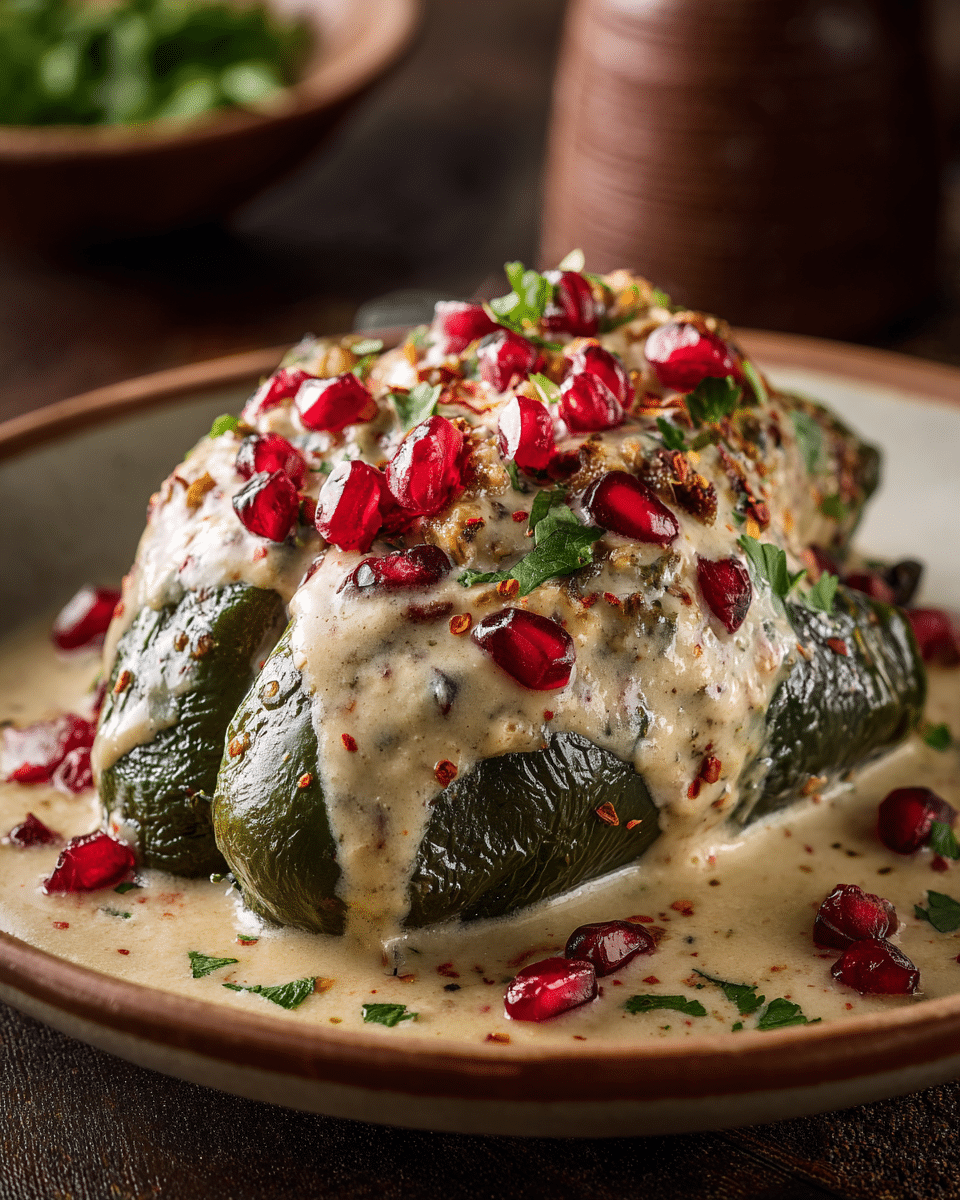Chiles en Nogada is one of Mexico’s most iconic and festive dishes, traditionally enjoyed during the month of September to celebrate Mexican Independence Day. Originating from Puebla, this recipe features poblano chiles stuffed with a savory-sweet picadillo made of ground meat, fruits, and spices, then topped with a rich walnut sauce (nogada) and garnished with fresh pomegranate seeds and parsley.
FULL RECIPE
Ingredients
1.For the Picadillo (Stuffing):
- 6 large poblano chiles, roasted, peeled, and deseeded
- 2 tablespoons vegetable oil
- 1 pound ground beef or pork (or a mix of both)
- 1 medium onion, finely chopped
- 2 cloves garlic, minced
- 2 medium tomatoes, finely chopped or pureed
- 1 medium apple, peeled and diced
- 1 medium pear, peeled and diced
- 1 medium peach, peeled and diced
- 1/4 cup raisins
- 1/4 cup slivered almonds, lightly toasted
- 1/4 cup candied fruit, diced (optional)
- 1/2 teaspoon ground cinnamon
- 1/4 teaspoon ground cloves
- 1/4 teaspoon ground black pepper
- 1 teaspoon salt (or to taste)
- 1/2 cup chicken broth
3.For the Nogada (Walnut Sauce):
- 1 cup fresh walnuts, peeled and soaked in milk for at least 2 hours
- 1/2 cup milk (plus extra for soaking)
- 1/2 cup Mexican crema or sour cream
- 1/4 cup queso fresco or mild white cheese, crumbled
- 2 tablespoons sugar (or to taste)
- 1/4 teaspoon ground cinnamon
- 1/4 teaspoon salt
3.For Garnish:
- 1/2 cup pomegranate seeds
- Fresh parsley leaves
Directions
- Prepare the Chiles: Roast the poblano chiles over an open flame or under a broiler until the skin is charred. Place them in a plastic bag or cover with a kitchen towel for 10 minutes to steam. Peel off the skin, make a small slit along one side, and carefully remove the seeds and veins. Set aside.
- Cook the Picadillo: Heat the vegetable oil in a large skillet over medium heat. Add the onion and garlic, sautéing until fragrant and translucent. Add the ground meat and cook until browned.
- Add Fruits and Nuts: Stir in the tomatoes, apple, pear, peach, raisins, almonds, and candied fruit. Mix well and cook for 5 minutes until the fruit softens slightly.
- Season the Mixture: Sprinkle in cinnamon, cloves, pepper, and salt. Pour in the chicken broth, reduce the heat, and let the mixture simmer for 10 minutes, allowing flavors to meld. Remove from heat.
- Stuff the Chiles: Carefully spoon the picadillo into each chile, closing them gently without tearing. Arrange them on a serving platter.
- Prepare the Nogada: Drain the soaked walnuts and place them in a blender. Add milk, crema, queso fresco, sugar, cinnamon, and salt. Blend until smooth and creamy. Adjust sweetness or thickness by adding more milk if needed.
- Assemble the Dish: Pour the walnut sauce generously over the stuffed chiles. Sprinkle with pomegranate seeds and garnish with parsley leaves.
- Serve: Best enjoyed at room temperature to fully appreciate the flavors and textures.
Nutrition Facts
- Calories: 480
- Protein: 22g
- Fat: 31g
- Saturated Fat: 11g
- Carbohydrates: 29g
- Fiber: 6g
- Sugar: 17g
- Sodium: 620mg
- Cholesterol: 85mg
Historical Significance of Chiles en Nogada
Chiles en Nogada is deeply tied to Mexican heritage, originating in the early 19th century in the city of Puebla. It is said to have been created by the Augustinian nuns of the Convent of Santa Monica to honor Agustín de Iturbide, a key figure in Mexico’s independence, when he visited Puebla. The dish’s red pomegranate seeds, white walnut sauce, and green parsley symbolized the colors of the newly formed Mexican flag. This combination of culinary artistry and patriotism has kept Chiles en Nogada as a treasured national dish, celebrated especially during September, the month of Mexico’s independence festivities.
Symbolism of the Colors
The visual presentation of Chiles en Nogada is one of its most captivating aspects, as it directly represents the Mexican flag. The green from the parsley signifies hope and independence, the white walnut sauce symbolizes purity and unity, and the red pomegranate seeds represent the blood shed for freedom. This tricolor arrangement is not just visually appealing but also carries a deep emotional connection for many Mexicans, making the dish a centerpiece of patriotic celebrations.
Unique Flavor Profile
Chiles en Nogada is known for its complex and harmonious balance of flavors, combining sweet, savory, and nutty elements in a single bite. The picadillo filling typically blends ground meat with fresh fruits such as apples, pears, and peaches, along with spices like cinnamon and cloves, creating a rich sweetness. This is perfectly complemented by the creamy walnut sauce, which adds a velvety texture and mild nuttiness. The pomegranate seeds provide a burst of tartness that balances the richness, ensuring that each mouthful is layered and memorable.
Regional Variations
While Puebla is the birthplace of Chiles en Nogada, variations exist across Mexico depending on local tastes and ingredient availability. Some cooks prefer using only beef, while others opt for pork or a combination of both. Certain recipes incorporate dried fruits or candied fruits for added sweetness, while others focus on fresher, lighter fillings. The walnut sauce may also vary, with some versions using almonds or even cashews as substitutes when fresh walnuts are unavailable. Each variation retains the essence of the dish while reflecting the personality of the cook and the resources of the region.
Seasonality and Freshness
Traditionally, Chiles en Nogada is a seasonal dish, best prepared between August and September when the key ingredients—poblano chiles, walnuts, pomegranates, and specific stone fruits—are at their peak. This timing aligns perfectly with Mexican Independence Day celebrations. Fresh walnuts are particularly prized for their mild flavor, while ripe seasonal fruits provide natural sweetness without the need for excessive sugar. Using ingredients at their freshest ensures the best flavor and texture, which is why many Mexicans eagerly await the short window of the year when this dish is most authentic.
Health Benefits
Although Chiles en Nogada is a festive and indulgent dish, it also contains several nutritious components. Poblano chiles are a good source of vitamins A and C, while walnuts provide healthy fats, particularly omega-3 fatty acids, which support heart health. The inclusion of fresh fruits adds dietary fiber and antioxidants, and the lean ground meat contributes to protein intake. While the walnut sauce can be calorie-dense, mindful portion control allows one to enjoy the dish while still benefiting from its nutrient-rich ingredients.
Serving Suggestions
Chiles en Nogada is best served at room temperature, allowing the flavors of the picadillo and the walnut sauce to meld without one overpowering the other. It can be presented as a main course on a large platter or served individually for a more elegant dining experience. Garnishing generously with pomegranate seeds and fresh parsley not only adds color contrast but also enhances freshness. Serving the dish with warm tortillas or a side of white rice can help balance its richness, while a crisp salad provides a refreshing counterpoint.
Beverage Pairings
Pairing the right beverage with Chiles en Nogada enhances the dining experience. For a traditional approach, a glass of Mexican white wine, such as a Chenin Blanc or Sauvignon Blanc, complements the creamy sauce and sweet-salty filling. Sparkling wines or light champagnes work well for festive occasions, offering a refreshing contrast to the richness of the dish. Non-alcoholic options like hibiscus tea (agua de jamaica) or a light citrus-infused water also pair beautifully, adding tartness and cleansing the palate between bites.
Storage and Reheating Tips
Chiles en Nogada can be stored in the refrigerator for up to three days if kept in an airtight container. It is recommended to store the stuffed chiles and walnut sauce separately to maintain texture and prevent sogginess. When ready to serve, bring the chiles to room temperature and pour the sauce over them just before plating. While the dish can be reheated gently, the walnut sauce is best enjoyed fresh to preserve its flavor and creamy consistency. Freezing is generally not advised, as the sauce may separate upon thawing.
Conclusion
Chiles en Nogada is far more than just a recipe it is a symbol of Mexico’s history, identity, and culinary artistry. Its vibrant colors, intricate flavors, and cultural significance make it a dish worth celebrating, especially during national holidays. Whether prepared in its traditional form or adapted to suit modern tastes, it captures the essence of Mexican hospitality and pride.






